2015 NISSAN LEAF warning
[x] Cancel search: warningPage 84 of 412
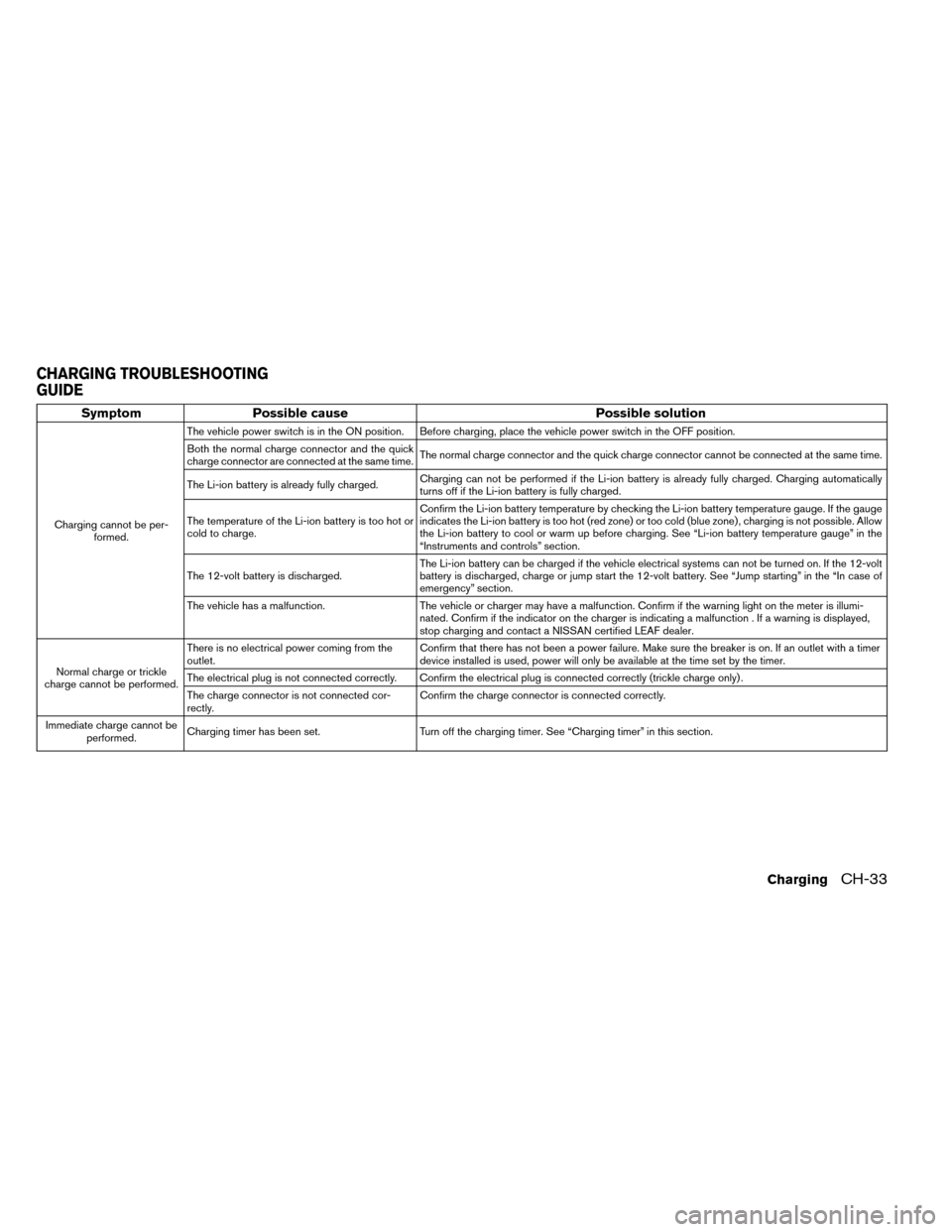
SymptomPossible cause Possible solution
Charging cannot be per-
formed. The vehicle power switch is in the ON position. Before charging, place the vehicle power switch in the OFF position.
Both the normal charge connector and the quick
charge connector are connected at the same time.
The normal charge connector and the quick charge connector cannot be connected at the same time.
The Li-ion battery is already fully charged. Charging can not be performed if the Li-ion battery is already fully charged. Charging automatically
turns off if the Li-ion battery is fully charged.
The temperature of the Li-ion battery is too hot or
cold to charge. Confirm the Li-ion battery temperature by checking the Li-ion battery temperature gauge. If the gauge
indicates the Li-ion battery is too hot (red zone) or too cold (blue zone) , charging is not possible. Allow
the Li-ion battery to cool or warm up before charging. See “Li-ion battery temperature gauge” in the
“Instruments and controls” section.
The 12-volt battery is discharged. The Li-ion battery can be charged if the vehicle electrical systems can not be turned on. If the 12-volt
battery is discharged, charge or jump start the 12-volt battery. See “Jump starting” in the “In case of
emergency” section.
The vehicle has a malfunction. The vehicle or charger may have a malfunction. Confirm if the warning light on the meter is illumi-
nated. Confirm if the indicator on the charger is indicating a malfunction . If a warning is displayed,
stop charging and contact a NISSAN certified LEAF dealer.
Normal charge or trickle
charge cannot be performed. There is no electrical power coming from the
outlet.
Confirm that there has not been a power failure. Make sure the breaker is on. If an outlet with a timer
device installed is used, power will only be available at the time set by the timer.
The electrical plug is not connected correctly. Confirm the electrical plug is connected correctly (trickle charge only) .
The charge connector is not connected cor-
rectly. Confirm the charge connector is connected correctly.
Immediate charge cannot be performed. Charging timer has been set.
Turn off the charging timer. See “Charging timer” in this section.
CHARGING TROUBLESHOOTING
GUIDE
ChargingCH-33
Page 88 of 412
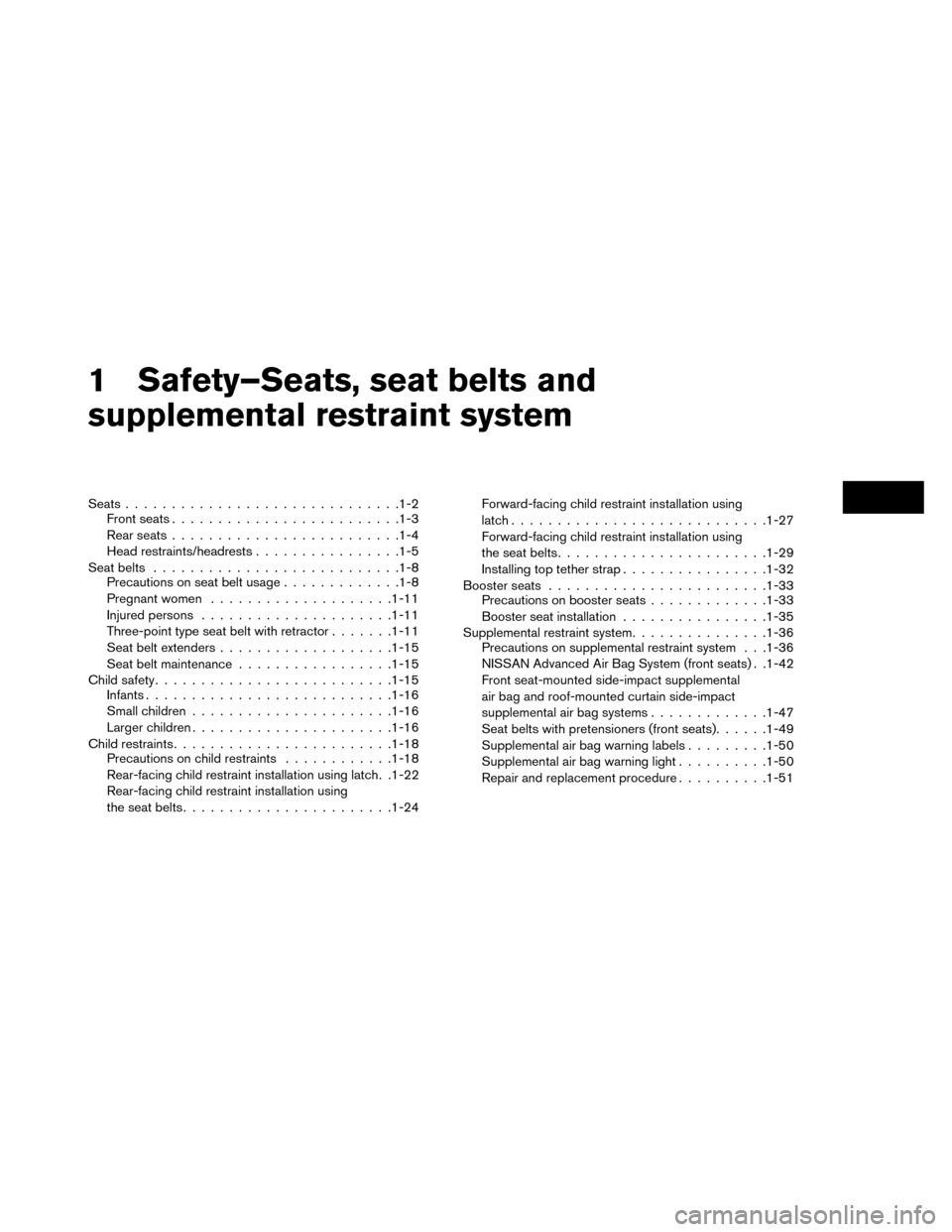
1 Safety–Seats, seat belts and
supplemental restraint system
Seats............................. .1-2
Front seats ........................ .1-3
Rear seats ........................ .1-4
Head restraints/headrests ................1-5
Seat belts .......................... .1-8
Precautions on seat belt usage .............1-8
Pregnant women ................... .1-11
Injured persons .................... .1-11
Three-point type seat belt with retractor .......1-11
Seat belt extenders .................. .1-15
Seat belt maintenance ................ .1-15
Child safety ......................... .1-15
Infants .......................... .1-16
Small children ..................... .1-16
Larger children ..................... .1-16
Child restraints ....................... .1-18
Precautions on child restraints ............1-18
Rear-facing child restraint installation using latch. .1-22
Rear-facing child restraint installation using
the seat belts ...................... .1-24Forward-facing child restraint installation using
latch
........................... .1-27
Forward-facing child restraint installation using
the seat belts ...................... .1-29
Installing top tether strap ................1-32
Booster seats ....................... .1-33
Precautions on booster seats .............1-33
Booster seat installation ................1-35
Supplemental restraint system ...............1-36
Precautions on supplemental restraint system . . .1-36
NISSAN Advanced Air Bag System (front seats) . .1-42
Front seat-mounted side-impact supplemental
air bag and roof-mounted curtain side-impact
supplemental air bag systems .............1-47
Seat belts with pretensioners (front seats) ......1-49
Supplemental air bag warning labels .........1-50
Supplemental air bag warning light ..........1-50
Repair and replacement procedure ..........1-51
Page 89 of 412
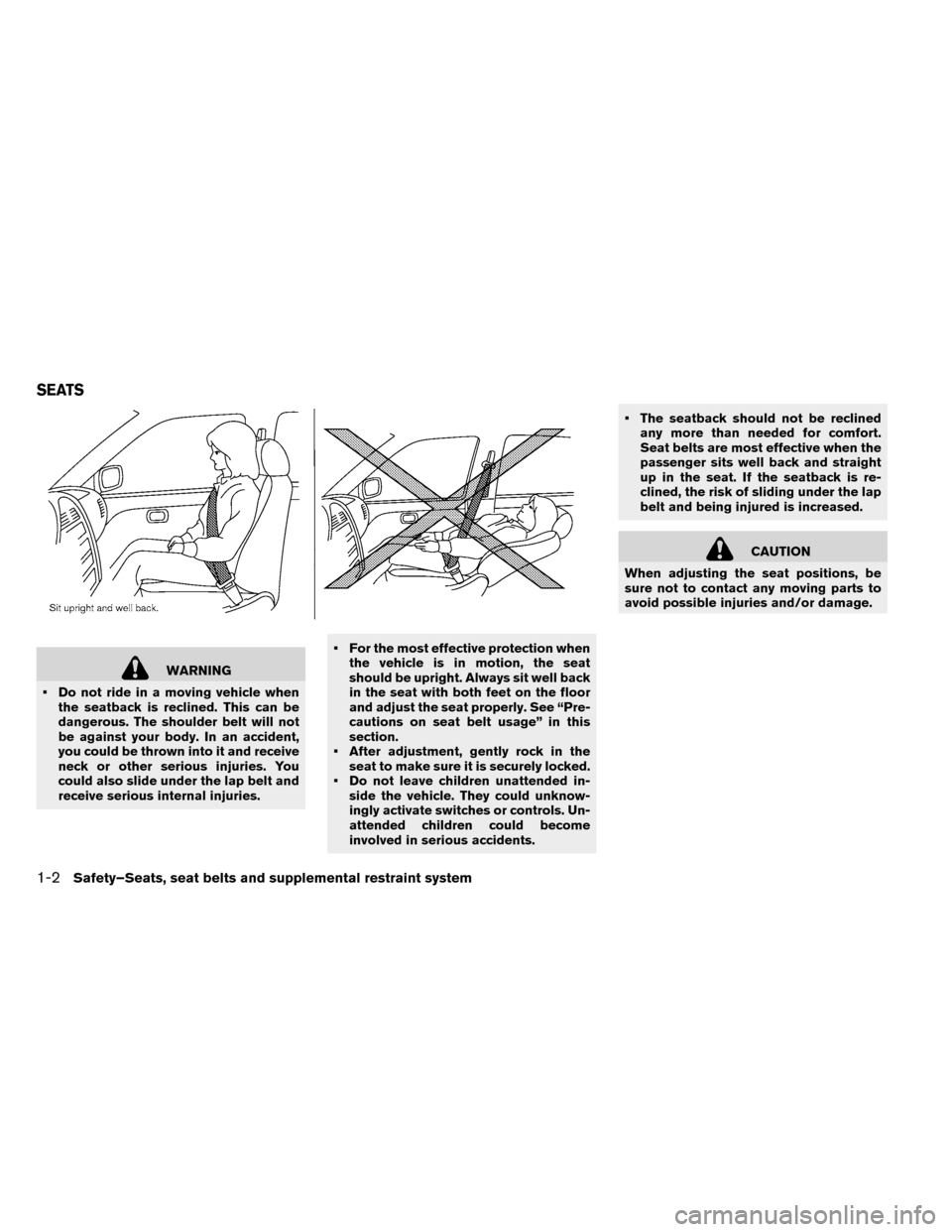
WARNING
• Do not ride in a moving vehicle when the seatback is reclined. This can be
dangerous. The shoulder belt will not
be against your body. In an accident,
you could be thrown into it and receive
neck or other serious injuries. You
could also slide under the lap belt and
receive serious internal injuries. • For the most effective protection when
the vehicle is in motion, the seat
should be upright. Always sit well back
in the seat with both feet on the floor
and adjust the seat properly. See “Pre-
cautions on seat belt usage” in this
section.
• After adjustment, gently rock in the seat to make sure it is securely locked.
• Do not leave children unattended in- side the vehicle. They could unknow-
ingly activate switches or controls. Un-
attended children could become
involved in serious accidents. • The seatback should not be reclined
any more than needed for comfort.
Seat belts are most effective when the
passenger sits well back and straight
up in the seat. If the seatback is re-
clined, the risk of sliding under the lap
belt and being injured is increased.
CAUTION
When adjusting the seat positions, be
sure not to contact any moving parts to
avoid possible injuries and/or damage.
SEATS
1-2Safety–Seats, seat belts and supplemental restraint system
Page 91 of 412
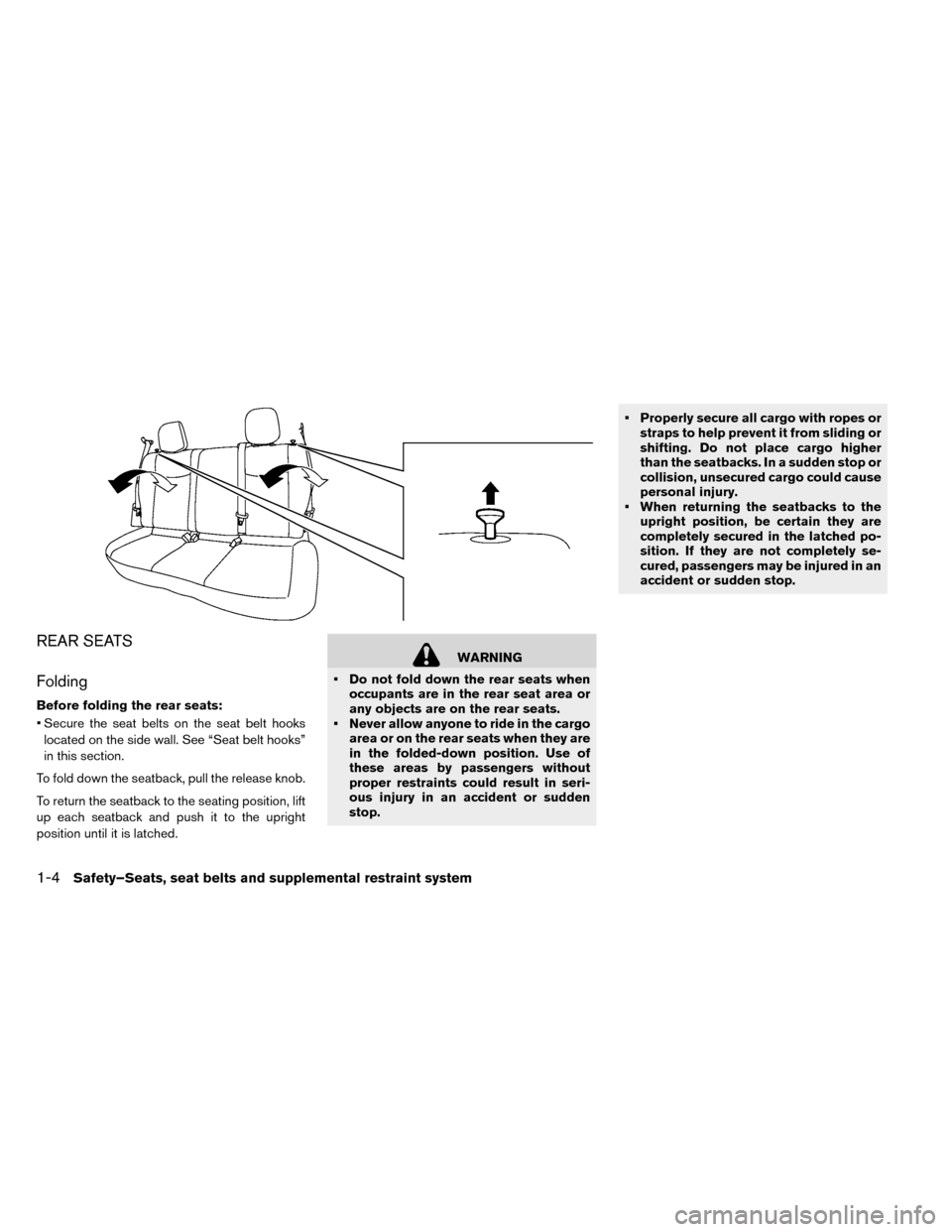
REAR SEATS
Folding
Before folding the rear seats:
• Secure the seat belts on the seat belt hookslocated on the side wall. See “Seat belt hooks”
in this section.
To fold down the seatback, pull the release knob.
To return the seatback to the seating position, lift
up each seatback and push it to the upright
position until it is latched.
WARNING
• Do not fold down the rear seats when occupants are in the rear seat area or
any objects are on the rear seats.
• Never allow anyone to ride in the cargo area or on the rear seats when they are
in the folded-down position. Use of
these areas by passengers without
proper restraints could result in seri-
ous injury in an accident or sudden
stop. • Properly secure all cargo with ropes or
straps to help prevent it from sliding or
shifting. Do not place cargo higher
than the seatbacks. In a sudden stop or
collision, unsecured cargo could cause
personal injury.
• When returning the seatbacks to the upright position, be certain they are
completely secured in the latched po-
sition. If they are not completely se-
cured, passengers may be injured in an
accident or sudden stop.
1-4Safety–Seats, seat belts and supplemental restraint system
Page 92 of 412
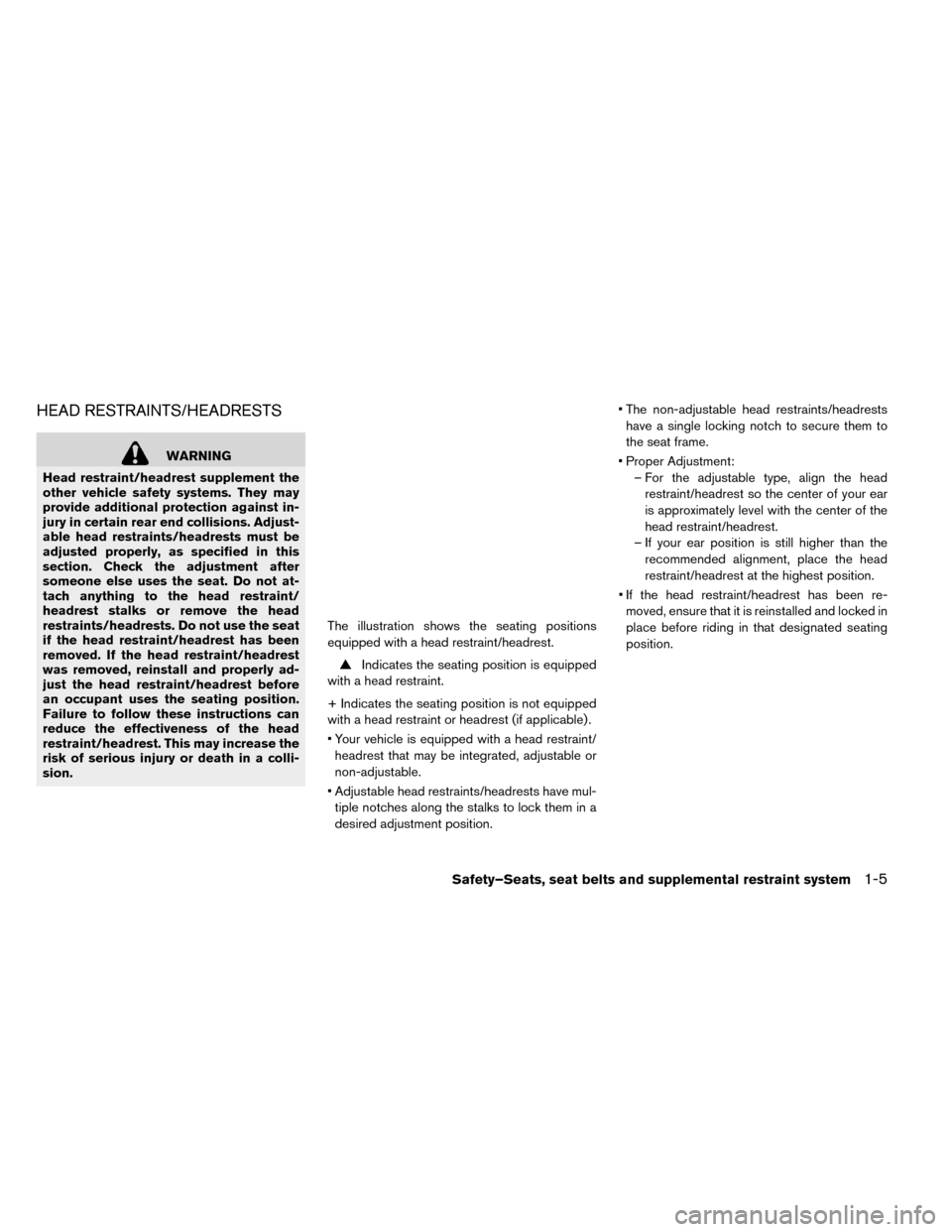
HEAD RESTRAINTS/HEADRESTS
WARNING
Head restraint/headrest supplement the
other vehicle safety systems. They may
provide additional protection against in-
jury in certain rear end collisions. Adjust-
able head restraints/headrests must be
adjusted properly, as specified in this
section. Check the adjustment after
someone else uses the seat. Do not at-
tach anything to the head restraint/
headrest stalks or remove the head
restraints/headrests. Do not use the seat
if the head restraint/headrest has been
removed. If the head restraint/headrest
was removed, reinstall and properly ad-
just the head restraint/headrest before
an occupant uses the seating position.
Failure to follow these instructions can
reduce the effectiveness of the head
restraint/headrest. This may increase the
risk of serious injury or death in a colli-
sion. The illustration shows the seating positions
equipped with a head restraint/headrest.
Indicates the seating position is equipped
with a head restraint.
+ Indicates the seating position is not equipped
with a head restraint or headrest (if applicable) .
• Your vehicle is equipped with a head restraint/ headrest that may be integrated, adjustable or
non-adjustable.
• Adjustable head restraints/headrests have mul- tiple notches along the stalks to lock them in a
desired adjustment position. • The non-adjustable head restraints/headrests
have a single locking notch to secure them to
the seat frame.
• Proper Adjustment: – For the adjustable type, align the headrestraint/headrest so the center of your ear
is approximately level with the center of the
head restraint/headrest.
– If your ear position is still higher than the recommended alignment, place the head
restraint/headrest at the highest position.
• If the head restraint/headrest has been re- moved, ensure that it is reinstalled and locked in
place before riding in that designated seating
position.
Safety–Seats, seat belts and supplemental restraint system1-5
Page 97 of 412
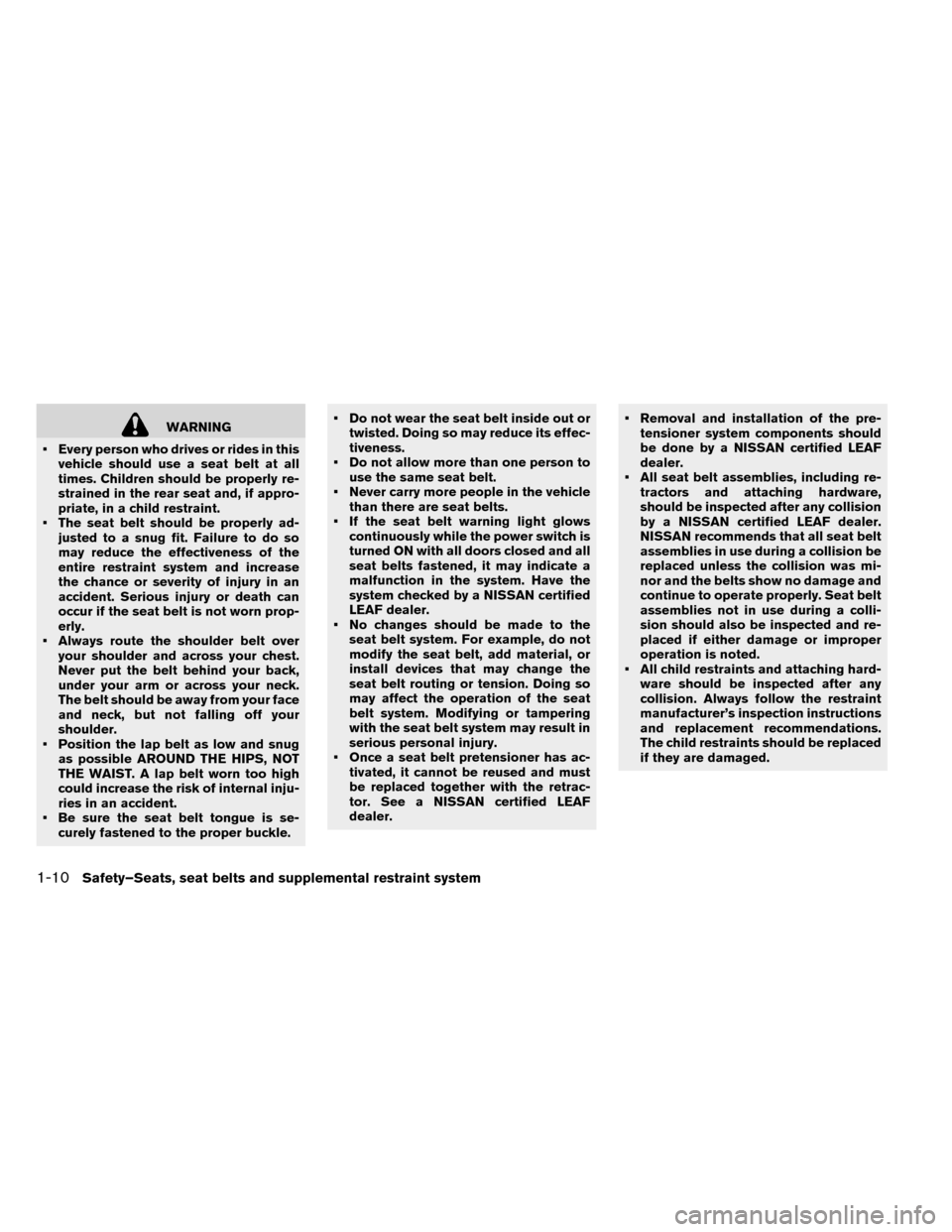
WARNING
• Every person who drives or rides in this vehicle should use a seat belt at all
times. Children should be properly re-
strained in the rear seat and, if appro-
priate, in a child restraint.
• The seat belt should be properly ad- justed to a snug fit. Failure to do so
may reduce the effectiveness of the
entire restraint system and increase
the chance or severity of injury in an
accident. Serious injury or death can
occur if the seat belt is not worn prop-
erly.
• Always route the shoulder belt over your shoulder and across your chest.
Never put the belt behind your back,
under your arm or across your neck.
The belt should be away from your face
and neck, but not falling off your
shoulder.
• Position the lap belt as low and snug as possible AROUND THE HIPS, NOT
THE WAIST. A lap belt worn too high
could increase the risk of internal inju-
ries in an accident.
• Be sure the seat belt tongue is se- curely fastened to the proper buckle. • Do not wear the seat belt inside out or
twisted. Doing so may reduce its effec-
tiveness.
• Do not allow more than one person to use the same seat belt.
• Never carry more people in the vehicle than there are seat belts.
• If the seat belt warning light glows continuously while the power switch is
turned ON with all doors closed and all
seat belts fastened, it may indicate a
malfunction in the system. Have the
system checked by a NISSAN certified
LEAF dealer.
• No changes should be made to the seat belt system. For example, do not
modify the seat belt, add material, or
install devices that may change the
seat belt routing or tension. Doing so
may affect the operation of the seat
belt system. Modifying or tampering
with the seat belt system may result in
serious personal injury.
• Once a seat belt pretensioner has ac- tivated, it cannot be reused and must
be replaced together with the retrac-
tor. See a NISSAN certified LEAF
dealer. • Removal and installation of the pre-
tensioner system components should
be done by a NISSAN certified LEAF
dealer.
• All seat belt assemblies, including re- tractors and attaching hardware,
should be inspected after any collision
by a NISSAN certified LEAF dealer.
NISSAN recommends that all seat belt
assemblies in use during a collision be
replaced unless the collision was mi-
nor and the belts show no damage and
continue to operate properly. Seat belt
assemblies not in use during a colli-
sion should also be inspected and re-
placed if either damage or improper
operation is noted.
• All child restraints and attaching hard- ware should be inspected after any
collision. Always follow the restraint
manufacturer’s inspection instructions
and replacement recommendations.
The child restraints should be replaced
if they are damaged.
1-10Safety–Seats, seat belts and supplemental restraint system
Page 98 of 412
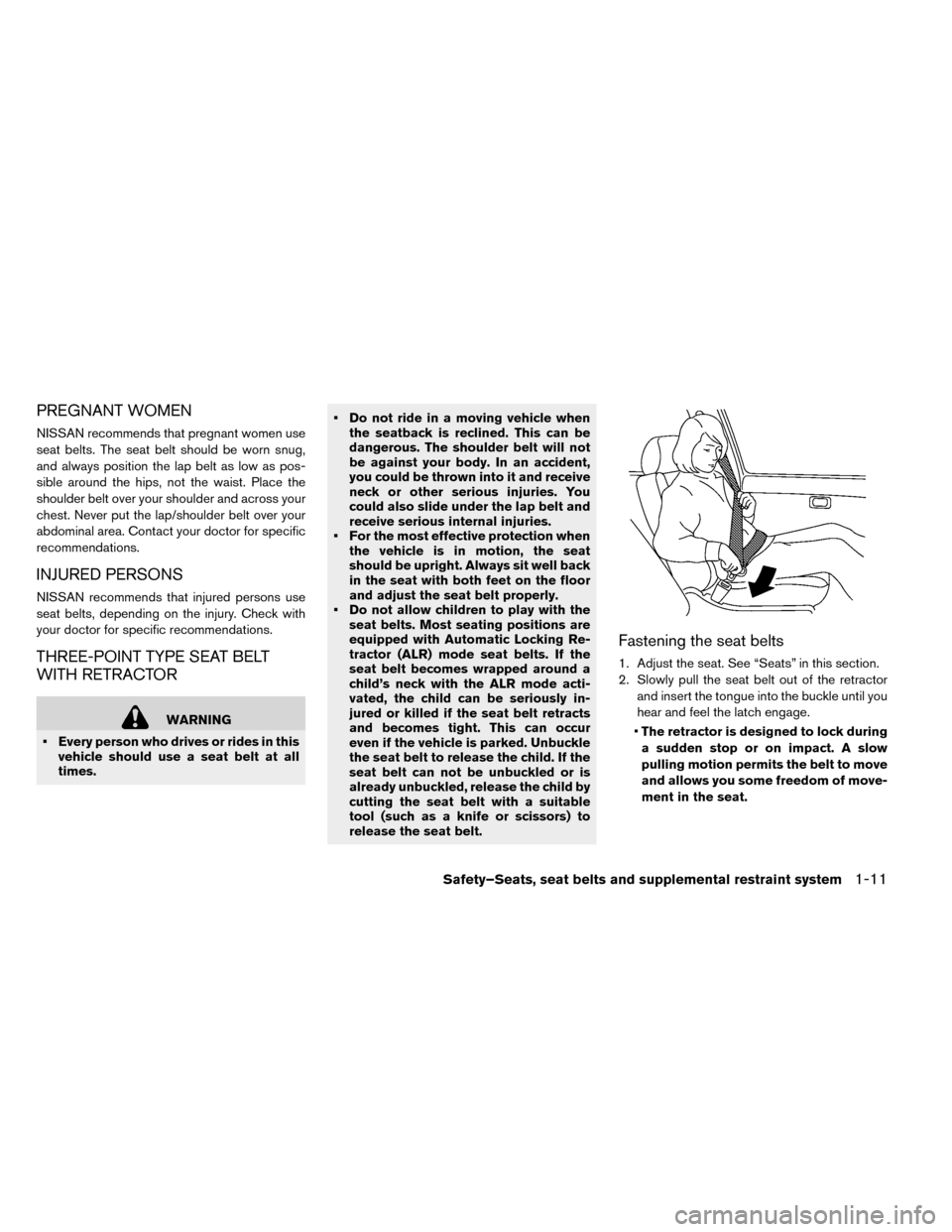
PREGNANT WOMEN
NISSAN recommends that pregnant women use
seat belts. The seat belt should be worn snug,
and always position the lap belt as low as pos-
sible around the hips, not the waist. Place the
shoulder belt over your shoulder and across your
chest. Never put the lap/shoulder belt over your
abdominal area. Contact your doctor for specific
recommendations.
INJURED PERSONS
NISSAN recommends that injured persons use
seat belts, depending on the injury. Check with
your doctor for specific recommendations.
THREE-POINT TYPE SEAT BELT
WITH RETRACTOR
WARNING
• Every person who drives or rides in this vehicle should use a seat belt at all
times. • Do not ride in a moving vehicle when
the seatback is reclined. This can be
dangerous. The shoulder belt will not
be against your body. In an accident,
you could be thrown into it and receive
neck or other serious injuries. You
could also slide under the lap belt and
receive serious internal injuries.
• For the most effective protection when the vehicle is in motion, the seat
should be upright. Always sit well back
in the seat with both feet on the floor
and adjust the seat belt properly.
• Do not allow children to play with the seat belts. Most seating positions are
equipped with Automatic Locking Re-
tractor (ALR) mode seat belts. If the
seat belt becomes wrapped around a
child’s neck with the ALR mode acti-
vated, the child can be seriously in-
jured or killed if the seat belt retracts
and becomes tight. This can occur
even if the vehicle is parked. Unbuckle
the seat belt to release the child. If the
seat belt can not be unbuckled or is
already unbuckled, release the child by
cutting the seat belt with a suitable
tool (such as a knife or scissors) to
release the seat belt.
Fastening the seat belts
1. Adjust the seat. See “Seats” in this section.
2. Slowly pull the seat belt out of the retractor
and insert the tongue into the buckle until you
hear and feel the latch engage.
• The retractor is designed to lock during
a sudden stop or on impact. A slow
pulling motion permits the belt to move
and allows you some freedom of move-
ment in the seat.
Safety–Seats, seat belts and supplemental restraint system1-11
Page 99 of 412
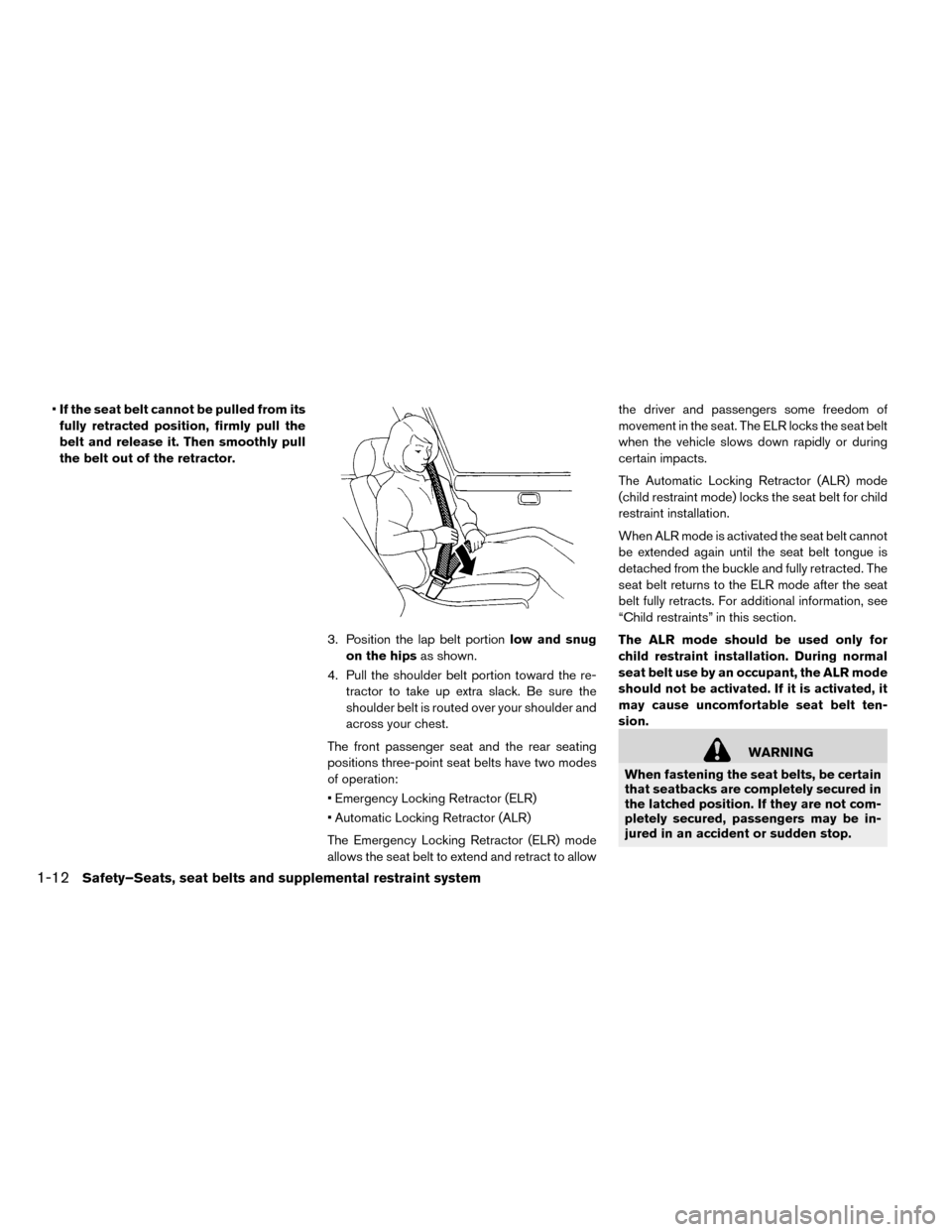
•If the seat belt cannot be pulled from its
fully retracted position, firmly pull the
belt and release it. Then smoothly pull
the belt out of the retractor.
3. Position the lap belt portionlow and snug
on the hips as shown.
4. Pull the shoulder belt portion toward the re- tractor to take up extra slack. Be sure the
shoulder belt is routed over your shoulder and
across your chest.
The front passenger seat and the rear seating
positions three-point seat belts have two modes
of operation:
• Emergency Locking Retractor (ELR)
• Automatic Locking Retractor (ALR)
The Emergency Locking Retractor (ELR) mode
allows the seat belt to extend and retract to allow the driver and passengers some freedom of
movement in the seat. The ELR locks the seat belt
when the vehicle slows down rapidly or during
certain impacts.
The Automatic Locking Retractor (ALR) mode
(child restraint mode) locks the seat belt for child
restraint installation.
When ALR mode is activated the seat belt cannot
be extended again until the seat belt tongue is
detached from the buckle and fully retracted. The
seat belt returns to the ELR mode after the seat
belt fully retracts. For additional information, see
“Child restraints” in this section.
The ALR mode should be used only for
child restraint installation. During normal
seat belt use by an occupant, the ALR mode
should not be activated. If it is activated, it
may cause uncomfortable seat belt ten-
sion.
WARNING
When fastening the seat belts, be certain
that seatbacks are completely secured in
the latched position. If they are not com-
pletely secured, passengers may be in-
jured in an accident or sudden stop.
1-12Safety–Seats, seat belts and supplemental restraint system